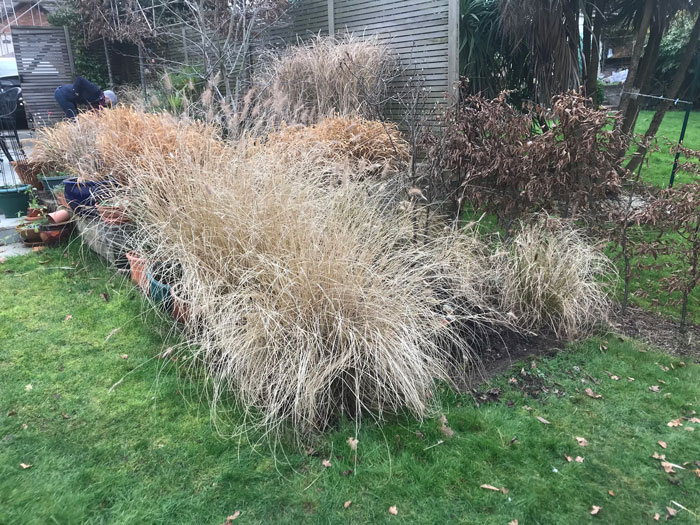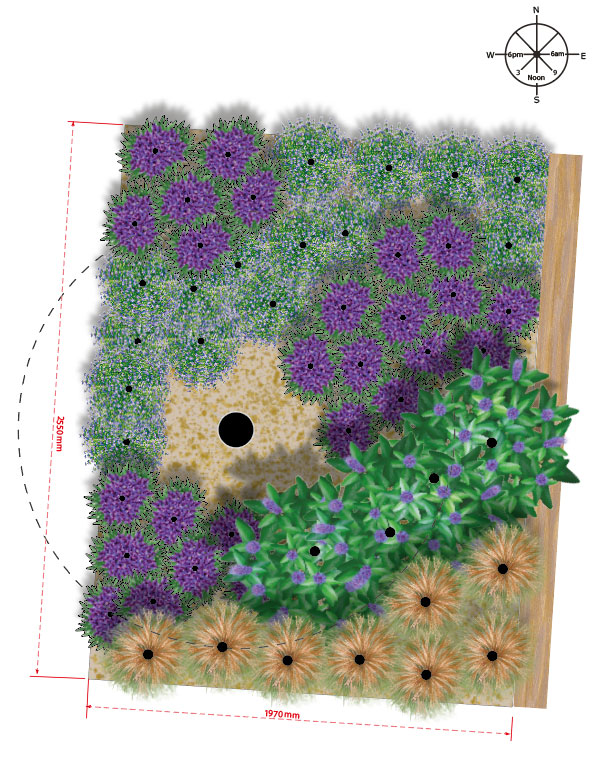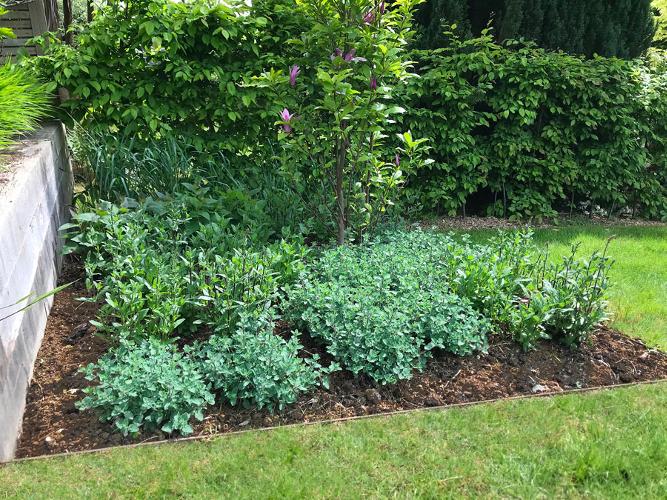refreshing a garden border with new texture and colour
Garden Design Brief
In this latest border creation, I was asked to re-design a rectangular shaped border that was becoming overwhelmed with existing and somewhat invasive grasses in the rear garden of retired professional couple from West Bergholt in North Essex.
The border had been originally designed and planted with what appeared to be Pennisetum alopecuroides, which had become dominant to an extent that the border had lost interest. Some of the Pennisetum had already been removed by the client to make way for a small Magnolia ‘Susan’ and the Magnolia was to remain within the new border design.
Much of the planting to the rest of the garden used grasses and low, formal evergreen hedging with some herbaceous planting. The new border design plan, needed to be sympathetic to the rest of the garden but inject new colour and texture.
The design was to be created mainly from herbaceous plants and/or shrubs and possibly some appropriate grasses. No evergreen plants were requested and the colour theme used within the new border should employ cooler colours from the blue, mauve and purple areas of the colour spectrum.
General observations
The border was situated to the left-hand side of the rear garden when viewed from the house facing west, close to an existing patio and the southern edge of the property. Being situated on a hill side residential area, the border also sloped down to the south and to the west
The boundary to the south of the property, adjacent to the border, was planted with a tall deciduous hedge.
The eastern edge of the border (that closest to the patio) had a wooden ‘sleeper’ boundary retaining a further raised border at patio level.
Due to its topographical level within the garden and its orientation, the border would receive good levels of sunlight for a large part of the day during the summer period and (due to the soil makeup) be well drained.


Garden Border design Solution
Primarily it was my intention to move the existing Magnolia tree towards the ‘sleeper’ wall and hedge as this would have acted as a backdrop to a new planting plan, when viewed across the garden, however, the client had stipulated that the Magnolia should not be moved. There was also one additional problem in that the original steel border edging had been installed with concrete ‘haunching’ on both sides of the steel, which resulted in not being able to plant to within at least 200mm of the border edge, so the plants had to spread above ground to cover this gap.
I therefore designed the border using the Magnolia as a backdrop when viewed from the patio area. It was established that the Magnolia ‘Susan’ in the border would have a mature height and eventual spread of between 2.5 to 4 metres. It is, however, a slow growing variety and is likely to take between 15 and 20 years to achieve its full potential. It also has an upright habit and not particularly dense. Subsequently, as it approaches maturity, is likely to cast some dappled shadow onto the surrounding plants to the eastern side during the afternoon. In spite of this, and for at least the next 5 to 10 years the border is going to enjoy a great deal of sunshine.
Planting
In regard to the planting firstly, I removed all the existing Pennisetum, which has now been transplanted to other areas of the garden. Plant choice would be governed by those plants which could tolerate full sun and dryish conditions and as the brief mentioned, the colour theme was stated as the blue, mauve and purple section of the gardening colour wheel.
With these circumstances in mind, I selected just three herbaceous perennials and one grass for the new plan, which were:
• Nepeta x faassenii ‘Kit Kat’
• Salvia nemorosa ‘Caradonna’
• Agastache ‘Blue fortune’
• Calamagrostis x acutifolia ‘Karl Foerster’
The three perennials are known for their ability to draw in pollinators and should provide a long flowering period through summer to early autumn within the colour theme stated. In addition, they all enjoy aromatic foliage.
The herbaceous planting has been arranged to fulfil two objectives. Although this is a relatively small border, I wanted to provide a planting scheme with a graduation of height and also separate repeating groups of at least one of the selected perennials. For this I have chosen the Salvia, as this has the more upright habit and the most dramatic colour of the three perennials.
Secondly, you will see from the drawing that the plants are also arranged in a primarily diagonal array from NE to SW. This will visually ‘extend’ the length of the border when viewed from the patio area situated to the NE and as you first enter the garden from the steps close to the border. The Black dot represents the space allocation for the young Magnolia.
The addition of Calamagrostis x acutifolia was to serve three purposes.
Firstly, although not within the colour palette, it was chosen to give the border unity with other areas of the garden, where other grasses exist.
Secondly, as it reaches maturity it will become the tallest part of the designs sloping gradient towards the Beech hedge to the south of the border and provide a defined edge to the border.
Finally, this particular grass will catch the late afternoon sunlight in the seed heads giving a dramatic display against the hedge.

Plants shown one month after spring planting


